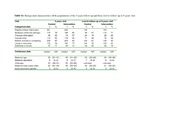| dc.description.abstract | Background: Breastfeeding promotion is regarded as one of the most effective interventions to improve child health, and could reduce under-5-mortality by 8 % globally. Few studies have assessed the health outcomes beyond infancy of interventions promoting exclusive breastfeeding. Methods: This study assessed growth in under-five children who participated in a cluster-randomised trial in Eastern Uganda (ClinicalTrials.gov.no.NCT00397150). In the intervention arm, peer counsellors promoted exclusive breastfeeding during the first 6 months of infancy. There were no interventions after 6 months of age. Mother-infant pairs were interviewed at visits scheduled at 3, 6, 12 and 24 weeks after birth and follow-up visits at 2 and 5 years, with 765 included in the analyses. Results: The mean length/height-for-age and weight-for-age-z-score (HAZ, WAZ) decreased with increasing age in both the intervention and control arms. At the three weeks visit, HAZ in the intervention was −0.45 (−0.68;−0.21) and −0.32 (−0.56;−0.07) in the control arm. At the 2 year follow-up, the mean HAZ in the intervention was −1.85 (95 % CI −1.97;−1.73) compared to −1.61 (−1.87;−1.34) in the control. Similarly, at the 5 year follow-up, the mean HAZ in the intervention was −1.78 (−2.08;−1.47) compared to −1.53 (−1.79;−1.28) in the control arm. At the 2 year follow-up visit, 139 (45 %) were stunted (HAZ<−2) in the intervention compared to 109 (37 %) in the control arm, odds ratio (OR) 1.7 (1.1;2.4). Underweight (WAZ<−2) was also more common in the intervention arm than in the control at the five years follow-up (OR 1.7 (1.0;2.8)), with a mean WAZ of −1.28 (−1.47;−1.08) and −1.06 (−1.19;−0.92) in the intervention and control arm, respectively. Conclusion: While stunting was widespread at 2 and 5 years of age in both arms, it was more common in the intervention arm. It is questionable whether community-based support from lay people with short training and focussing only on exclusive breastfeeding, is an appropriate strategy to improve child health and development. | en_US |


